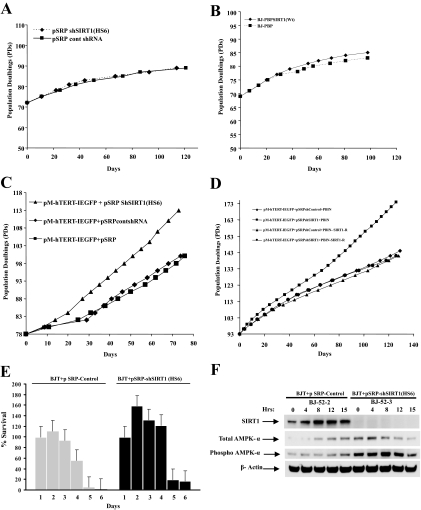Figure 3.
Cooperative effects of SIRT1 knockdown and hTERT expression on cell growth and survival. (A) SIRT1 suppression effects on lifespan of primary BJ fibroblasts. Late-passage BJ cells (≈7 PD before senescence) were infected with either pSRP-shControl or pSRPshSIRT1 (HS6) and pSRP control shRNA vector viruses and cells were subjected to selection in puromycin. (B) Overexpression of wild-type SIRT1 in primary BJ fibroblasts. Same as in A, except for the overexpression constructs (pBabe-Puro-wtSIRT1) and pBabe-Puro control vector were used. (C) Effects of SIRT1 knockdown on growth of BJT (hTERT-IRES-EGFP) fibroblasts. Late-passage BJ fibroblasts were infected with an hTERT containing virus, and the resulting BJT cells were subsequently infected by pSRP-shControl or BJ-pSRPshSIRT1 (HS6) viruses and subjected to a standard replicative lifespan assay. (D) Rescue of the biological effect of shRNA by an shRNA-resistant mutant. BJT cells were infected with pSRP-shControl or BJ-pSRPshSIRT1(HS6) viruses and subsequently infected with the rescue construct PBN-SIRT1-R or PBN control alone. Cells were kept under puromycin and neomycin selection throughout the experiments. BJT cells and their rescue counterparts generated were subjected to a long-term replicative assay as before to asses the ability of SIRT-R to rescue the phenotype of BJT cells expressing the SIRT1 shRNA. (E) BJT cells expressing control of SIRT1 shRNA were subjected to glucose withdrawal on day 0 and cell viability was measured for a week. Experiments were performed in duplicate dishes. Error bars, SEM. (F) Same strains as in E were subjected to glucose withdrawal and at the shown time point (hours after withdrawal), and cell lysates were prepared and subjected to immunoblotting with an anti-SIRT1, anti-phosphor-AMPK-α (Thr-172), total AMPK-α and β-actin antibodies.

